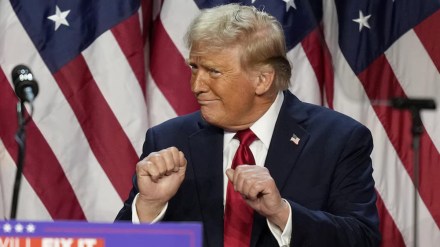By Rajan Kumar, Priyanshu Agarwal and Indrapal Gurjar
Donald Trump’s victory in the US presidential election has brought the Russia-Ukraine war to the forefront of global discussion again. During his election campaign, Trump claimed repeatedly that he would end the war within 24 hours of his assuming presidency. In his view, the Russia-Ukraine war is a futile drain of American resources, has led to a huge loss of military and civilian lives, and has the potential to escalate into a World War with nuclear repercussions. He further believes that Zelensky’s regime is corrupt, working in cahoots with the ‘deep state’ of the Biden administration. Therefore, he wants to end the war as quickly as possible.
Reportedly, Trump has initiated conversations with both presidents, Zelensky and Putin, and is trying to develop a template for a ceasefire. The situation in Ukraine has reached a critical point as Russian forces have advanced further in the eastern Donbas region and have also started a counteroffensive in the Kursk region. Making matters worse for Ukraine, nearly 10,000 North Korean soldiers have arrived in Russia to bolster Russian defence in the Kursk region. The Trump camp believes that Ukraine is unlikely to win this war against Russia, and, therefore, the former should be willing to make some territorial concessions to Russia.
Trump’s approach to the war stands in stark contrast to that of President Biden. While the Biden administration has spent nearly $175 billion in weapons and financial aid to Ukraine, Trump has threatened to stop funding the war as soon as he assumes power. He characterises Zelensky as a master salesman who walks away with billions of dollars every time he comes to the US. In contrast, he praises Russian military capability, which has a history of defeating Napoleon and Hitler. He considers Putin as a master-strategist and Zelensky as a showman. Therefore, he is likely to enforce a peace deal favourable to Moscow. If the latest reports are to be believed, he may defer the NATO membership to Ukraine for a specified period and may create a buffer zone with the help of European troops.
The Russia-Ukraine war has created inflationary pressure in the US, leading to a rise in the prices of gas and groceries. Trump made this a key electoral issue in his campaign against the Biden administration. He also believes that Europe is not contributing enough financially and that the burden of European security is being diverted to the US.
Trump’s scepticism about NATO, the military alliance of 32 countries created after World War 2, adds another layer of complexity. He has long criticised European countries for not spending a specified 2 percent of their GDP on defence expenditure as per NATO decisions, accusing them of relying too heavily on US funding. NATO’s former Secretary General Jens Stoltenberg articulated serious concern about Trump’s policies, fearing that it might weaken the European security architecture. Hungary’s prime minister, Viktor Orban, a close Trump ally, also raised similar concerns about NATO’s role in Ukraine in the absence of American support.
The territorial situation remains grim for Ukraine. Russia currently occupies about 20 percent of Ukrainian land, which consists of the entire Crimea, 80 percent of the Donbas region, and more than 70 per cent of the Zaporizhzhia and Kherson regions. President Putin has made it clear that Russia will not end the war until Ukraine accepts Russia’s control over Crimea, Donetsk, Luhansk and other territories. It remains to be seen how Trump convinces Putin to restore the status quo ante. Ukraine is unlikely to cede the territory to Russia in any negotiation. Therefore, peace negotiations are likely to be complicated, long-drawn and volatile.
Trump’s past statements about the war worry many Ukrainians. During his campaign, he suggested that Ukraine should have “given up a little bit” to Russia, claiming that “any deal, even the worst deal, would have been better than what we have right now.”
With the presidential transition underway, the Biden administration has intensified its support for Ukraine. Officials are fast-tracking military and financial aid packages before the January 20 handover, a move that could affect Trump’s declared plan for swift conflict resolution. Military experts warn that Ukraine faces a challenging period ahead. Beyond the threat of North Korean troops joining Russian forces, Ukraine’s military is dealing with ammunition shortages and exhausted soldiers after almost three years of continuous fighting. The recent Ukrainian counteroffensive did not achieve its main goals, and Russian forces are now on the offensive in several areas.
For European leaders, Trump’s victory means they must prepare for possible major changes in US foreign policy. His “America First” approach could mean significantly less American support for Ukraine, forcing European countries to dramatically increase their funding or watch Ukraine’s position weaken further.
The next few months will be crucial as the world waits to see how Trump’s return to power will affect the war. As Trump prepares to retake control of US foreign policy, Ukraine’s future hangs in the balance. The decisions made in the coming months could determine the fate of Ukraine and the future of European security and the emerging world order.
On the positive side, a second Trump presidency might ease India’s difficulty in treading a diplomatic tightrope between Russia and the US. Normalising ties between the two adversaries strengthens India’s position in the international security architecture.
Rajan Kumar is a Professor in the School of International Studies, JNU. Priyanshu and Indrapal are research scholars working on Russia in the School of International Studies, JNU.
Disclaimer: Views expressed are personal and do not reflect the official position or policy of FinancialExpress.com Reproducing this content without permission is prohibited.
